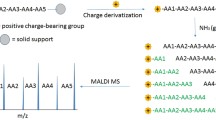Abstract
The solid-phase version of the Edman degradation, first described over 20 years ago (Laursen, 1966) and later automated (Laursen, 1971), takes advantage of the principle that proteins which are covalently linked to an insoluble matrix can readily be separated, without losses, from reagents and reaction products. The first commercial solid-phase sequencers were introduced in the early 1970’s and improvements in the technique, primarily in methods of protein immobilization, continued for several years more (Laursen and Machleidt, 1980). With the introduction (Hewick et al 1981) of the gas-phase protein sequencer, interest in the solid-phase technique declined, primarily because of the microsequencing capabilities of the newer instrument and because the protein immobilization steps were not required. Recently, however, there has been a resurgence of interest in solid-phase chemistry because of its advantages as a method for immobilizing proteins electroeluted from polyacrylamide gels and for preventing losses of material with ultramicrosequencing techniques (Aebersold et al 1988).
Access this chapter
Tax calculation will be finalised at checkout
Purchases are for personal use only
Preview
Unable to display preview. Download preview PDF.
Similar content being viewed by others
References
Aebersold RH, Pipes GD, Nika H, Hood LE and Kent SBH (1988) Covalent immobilization of proteins for high sensitivity sequence analysis; electroblotting onto chemically-activated glass from SDS-polyacrylamide gels. Biochemistry (in press)
Hewick RM, Hunkapiller MW, Hood LE, and Dreyer WJ (1981) A gas- liquid solid phase peptide and protein sequenator. J Biol Chem 256: 7990–7997
Laursen RA (1966) A solid-state Edman degradation. J Am Chem Soc 88: 5344–5346
Laursen RA (1971) Solid-phase Edman degradation An automatic peptide sequencer. Eur J Biochem 20: 89 – 102
Laursen RA and Machleidt W (1980) Solid-phase methods in pro- protein sequence analysis. Methods Biochem Anal 26: 201–284
Walker JE, Fearnley, IM and Blows RA (1986) A rapid solid-phase protein microsequencer. Biochem J 237: 73–84
Author information
Authors and Affiliations
Editor information
Editors and Affiliations
Rights and permissions
Copyright information
© 1989 Springer-Verlag Berlin Heidelberg
About this chapter
Cite this chapter
Laursen, R.A. et al. (1989). A Second Generation Solid-phase Protein Sequencer: The Prosequencer™. In: Wittmann-Liebold, B. (eds) Methods in Protein Sequence Analysis. Springer, Berlin, Heidelberg. https://doi.org/10.1007/978-3-642-73834-0_9
Download citation
DOI: https://doi.org/10.1007/978-3-642-73834-0_9
Publisher Name: Springer, Berlin, Heidelberg
Print ISBN: 978-3-642-73836-4
Online ISBN: 978-3-642-73834-0
eBook Packages: Springer Book Archive




